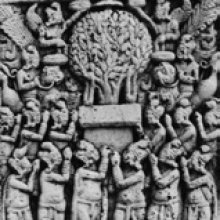Adhyeshana, Adhyeṣaṇā, Adhyeṣaṇa: 12 definitions
Introduction:
Adhyeshana means something in Buddhism, Pali, Hinduism, Sanskrit. If you want to know the exact meaning, history, etymology or English translation of this term then check out the descriptions on this page. Add your comment or reference to a book if you want to contribute to this summary article.
The Sanskrit terms Adhyeṣaṇā and Adhyeṣaṇa can be transliterated into English as Adhyesana or Adhyeshana, using the IAST transliteration scheme (?).
Images (photo gallery)
In Buddhism
Mahayana (major branch of Buddhism)
Source: Wisdom Library: Maha Prajnaparamita SastraAdhyeṣaṇā (अध्येषणा, “invitation”) refers to a quality of a Bodhisattva accompanying the Buddha at Rājagṛha on the Gṛdhrakūṭaparvata, according to the 2nd century Mahāprajñāpāramitāśāstra chapter 13. The Bodhisattvas excelled in inviting innumerable Buddhas. The invitations which they address to the Buddhas are of two types (Namely, adhyeṣaṇā, invitation, and yācanā, prayer).

Mahayana (महायान, mahāyāna) is a major branch of Buddhism focusing on the path of a Bodhisattva (spiritual aspirants/ enlightened beings). Extant literature is vast and primarely composed in the Sanskrit language. There are many sūtras of which some of the earliest are the various Prajñāpāramitā sūtras.
Tibetan Buddhism (Vajrayana or tantric Buddhism)
Source: OSU Press: Cakrasamvara SamadhiAdhyeṣaṇa (अध्येषण) refers “solicitation” and represents one of the “seven types of worship” (pūjā), according to Buddhist teachings followed by the Newah in Nepal, Kathmandu Valley (whose roots can be traced to the Licchavi period, 300-879 CE).—The connection that Vajrayāna has to the Mahāyāna is expressed through the saptavidhānottara-pūjā, "the seven-fold supreme offering", a seven step procedure for setting the intention to become a Buddha. Adhyeṣaṇa ("solicitation") refers to asking the Buddhas and Bodhisattvas to come again and again until all beings are enlightened.

Tibetan Buddhism includes schools such as Nyingma, Kadampa, Kagyu and Gelug. Their primary canon of literature is divided in two broad categories: The Kangyur, which consists of Buddha’s words, and the Tengyur, which includes commentaries from various sources. Esotericism and tantra techniques (vajrayāna) are collected indepently.
General definition (in Buddhism)
Source: Wisdom Library: Dharma-samgrahaAdhyeṣaṇā (अध्येषणा, “requesting instruction”) represents one of the “sevent supreme offerings” (saptavidhā-anuttarapūjā) as defined in the Dharma-saṃgraha (section 14). The Dharma-samgraha (Dharmasangraha) is an extensive glossary of Buddhist technical terms in Sanskrit (e.g., saptavidhā-anuttarapūjā and Adhyeṣaṇā). The work is attributed to Nagarguna who lived around the 2nd century A.D.
Languages of India and abroad
Sanskrit dictionary
Source: DDSA: The practical Sanskrit-English dictionaryAdhyeṣaṇa (अध्येषण).—[adhi-iṣ prairaṇe-lyuṭ] Causing one to do a thing, especially a preceptor &c. as an honorific duty.
-ṇā [adhikā eṣaṇā prārthanā] Solicitation, entreaty.
Derivable forms: adhyeṣaṇam (अध्येषणम्).
Source: Cologne Digital Sanskrit Dictionaries: Edgerton Buddhist Hybrid Sanskrit DictionaryAdhyeṣaṇa (अध्येषण).—nt., °ṇā, f. (to next with -ana; Sanskrit °ṇa recorded once, Kull. on Manu 1.2; °ṇā Lex.; Pali ajjhesanā), request (for instruction): °ṇa Mahāvyutpatti 861 (-buddhādhyeṣaṇa-); Bhadracarī 12 (verse); °ṇā Saddharmapuṇḍarīka 38.8 (all Nepalese mss. °ṇa); 178.15; 315.11; 404.9; Lalitavistara 7.13; 395.17; Bodhisattvabhūmi 75.6 (saddharmade- śanāyai); Dharmasaṃgraha 14; Sādhanamālā 64.7. The fem. is much commoner than the nt. In Lalitavistara 53.11 and 178.19 (verses) text kileśa-dhyeṣaṇā(t); read kileśadharṣaṇā(t); some mss. dhyaṣaṇāt, dhyāṣaṇā.
Source: Cologne Digital Sanskrit Dictionaries: Shabda-Sagara Sanskrit-English DictionaryAdhyeṣaṇā (अध्येषणा).—f.
(-ṇā) 1. Request, solicitation. 2. Asking, begging. E. adhi, iṣa to wish, and lyu aff.
Source: Cologne Digital Sanskrit Dictionaries: Monier-Williams Sanskrit-English Dictionary1) Adhyeṣaṇa (अध्येषण):—[=adhy-eṣaṇa] [from adhīṣṭa] a f(ā)n. solicitation, asking for instruction.
2) [=adhy-eṣaṇa] b See adhīṣṭa.
Source: Cologne Digital Sanskrit Dictionaries: Goldstücker Sanskrit-English DictionaryAdhyeṣaṇa (अध्येषण):—[tatpurusha compound] f. n.
(-ṇā-ṇam) Solicitation, asking, request. E. iṣ with adhi, kṛt aff. yuc.
Source: Cologne Digital Sanskrit Dictionaries: Yates Sanskrit-English DictionaryAdhyeṣaṇā (अध्येषणा):—[adhye+ṣaṇā] (ṇā) 1. f. Request.
Source: DDSA: Paia-sadda-mahannavo; a comprehensive Prakrit Hindi dictionary (S)Adhyeṣaṇā (अध्येषणा) in the Sanskrit language is related to the Prakrit word: Ajbhesaṇā.
[Sanskrit to German]
Sanskrit, also spelled संस्कृतम् (saṃskṛtam), is an ancient language of India commonly seen as the grandmother of the Indo-European language family (even English!). Closely allied with Prakrit and Pali, Sanskrit is more exhaustive in both grammar and terms and has the most extensive collection of literature in the world, greatly surpassing its sister-languages Greek and Latin.
See also (Relevant definitions)
Partial matches: Esana.
Ends with: Pradhyeshana, Punahpradhyeshana.
Full-text: Saptavidhanuttarapuja, Ajbhesana, Adhyesha, Anuttarapuja, Puja, Vandana, Triskandha.
Relevant text
Search found 3 books and stories containing Adhyeshana, Adhyeṣaṇā, Adhyesana, Adhyeṣaṇa, Adhy-eshana, Adhy-eṣaṇa, Adhy-esana; (plurals include: Adhyeshanas, Adhyeṣaṇās, Adhyesanas, Adhyeṣaṇas, eshanas, eṣaṇas, esanas). You can also click to the full overview containing English textual excerpts. Below are direct links for the most relevant articles:
Maha Prajnaparamita Sastra (by Gelongma Karma Migme Chödrön)
Appendix 4 - Triskandha (threefold practice): confession, commemoration, rejoicing < [Chapter XIII - The Buddha-fields]
Bodhisattva quality 27: excelled in inviting innumerable Buddhas < [Chapter XIII - The Buddha-fields]
Part 1 - Explanation of the word ‘evam’ < [Chapter II - Evam Mayā Śrutam Ekasmin Samaye]
Vakyapadiya of Bhartrihari (by K. A. Subramania Iyer)
Verse 3.7.125 < [Book 3 - Pada-kāṇḍa (7): Sādhana-samuddeśa (On the Means)]
Mimamsa interpretation of Vedic Injunctions (Vidhi) (by Shreebas Debnath)


